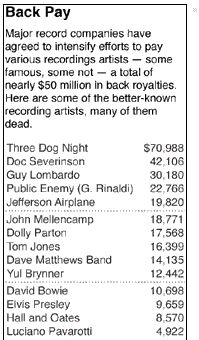 The major record labels couldn't find some big-name artists to whom they owed royalties, but they could find another grandmother to sue.
The major record labels couldn't find some big-name artists to whom they owed royalties, but they could find another grandmother to sue.
Good work from NY Attorney General Eliot Spitzer gets the record labels to track down such artists as Luciano Pavarotti and the estate of Elvis Presley, whom they couldn't seem to find in order to deliver royalty checks. Says Spitzer of the live performers, "It's not like it's hard to find them. You could go to a concert and throw the check at them onstage."
Maybe the failure to find artists comes from the record labels' other preoccupation, dragnetting John and Jane Does in the war against filesharers. Among the dolphins caught in the last round was a Fayetteville grandmother targetted for her grandson's music downloads. Let's get priorities straight here.
The New York Times reviews Jon Rouston's movie theater videos, shots of the screen, audience, and ambience at various opening-day movie showings. Critic's Notebook: When One Man's Video Art Is Another's Copyright Crime . The problem is that this art has been outlawed in many states. That's a side effect of the broad anti-camcorder statutes the MPAA has been pushing on many states, including California, despite the fact that its own insiders leak most movies to the public pre-release (study PDF).
It used to be the critics who'd tell us whether art was good or bad, original or imitative. Now it's the lawyers. As the reviewer comments on art's impoverished field:
It does not matter whether you think that Mr. Routson's work is good or bad art; it is quite good enough, in my view. It does matter that the no-camcorder laws may not do much to stem pirating while making it increasingly difficult for artists to do one of the things they do best: comment on the world around them.